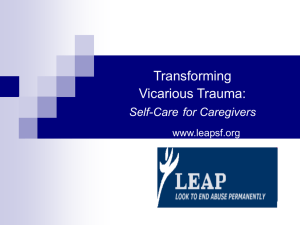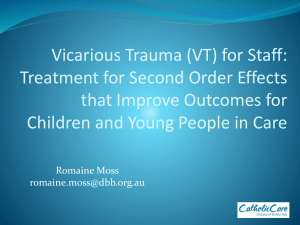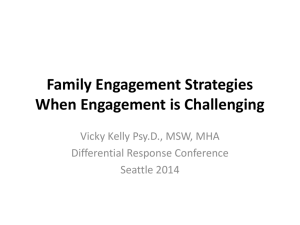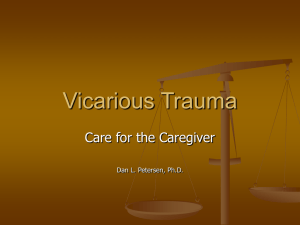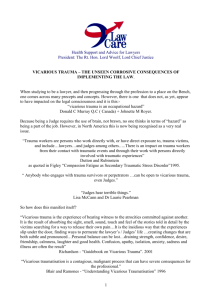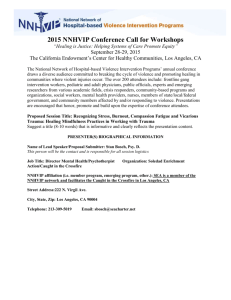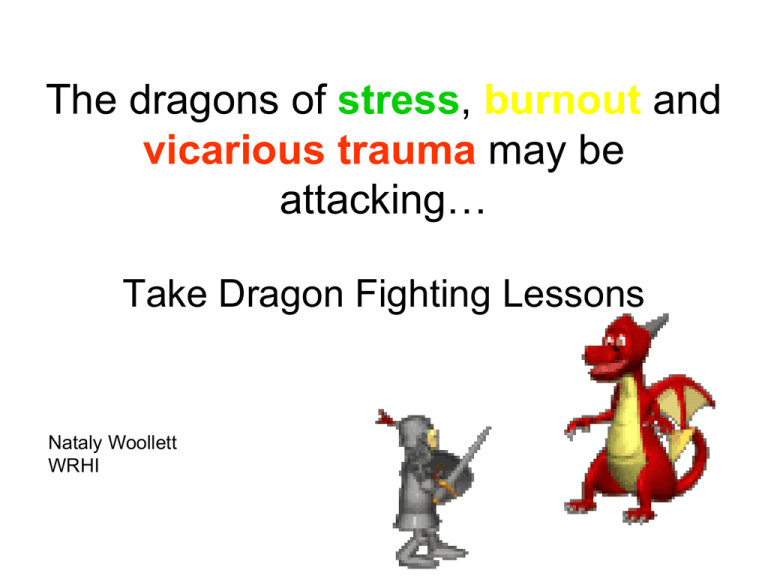
The dragons of stress, burnout and
vicarious trauma may be
attacking…
Take Dragon Fighting Lessons
Nataly Woollett
WRHI
… or get fried.
What Makes us Vulnerable in our
Work Context?
•
•
•
•
•
•
•
empathy;
personal experience;
workload;
age, experience & qualifications/perceptions of it;
hearing the heart-wrenching, shocking stories;
wanting to make a difference;
guilt and discomfort.
Stress Management Lessons
1. Identify what you are struggling with:
stress; burnout; vicarious trauma
2. Understand the impact and the
environment contributing to it
3. Know your strengths, weaknesses and
resources
4. Create some strategies
WHO Definition of Health (1946)
"a state of complete physical, mental, and
social well-being and not merely the
absence of disease or infirmity.“
Mental ill-health is associated with physical
ill-health and vice versa…
Stress
• appears when the demands are greater
than our resources
Stress Warning Signs and
Symptoms
1. Cognitive Symptoms
Memory problems
Inability to concentrate
Poor judgment
Seeing only the negative
Anxious or racing thoughts
Constant worrying
3. Physical Symptoms
Aches and pains
Diarrhoea or constipation
Nausea, dizziness
Chest pain, rapid heartbeat
Loss of sex drive
Frequent colds
2. Emotional Symptoms
Moodiness
Irritability or short temper
Agitation, inability to relax
Feeling overwhelmed
Sense of loneliness and isolation
Depression or general unhappiness
4. Behavioral Symptoms
Eating more or less
Sleeping too much or too little
Isolating yourself from others
Procrastinating or neglecting responsibilities
Using alcohol, cigarettes, or drugs to relax
Nervous habits (e.g. nail biting, pacing)
Burnout
• state of physical, emotional and mental exhaustion
caused by long term involvement in emotionally
demanding situation
• “the total psychic energy of a person is consumed in
trying to maintain the fires of existence” – energy crisis
• Tiredness, emotional depletion, too much caring and too
little self caring
• Burnout has 3 dimensions:
– Emotional exhaustion
– Depersonalization (negative attitude towards patients)
– Reduced personal accomplishment and commitment
The environment: Burnout
•
•
•
•
•
•
•
Workload
Control issues
Lack of reward
Absence of support or community
Lack of fairness
Discordant values
The stories
James2008
Potential Impact of Stress and
Burnout
Service provider
• Fatigue and inattention: increased
•
errors in judgment, increased
workplace injuries
•
• Behavioral changes: irritability,
somatic complaints, substance
abuse; distancing from family and
friends
•
• Anger, fear, guilt
• Depression: inability to cope
• Fear of stigma/violence: increased
focus on self and insensitive to
patients
• Absenteeism, tardiness, poor job
performance; colleague/
interpersonal conflict
Patient
Decreased quality of care
Physical or verbal abuse towards
patients
Insensitivity to the needs of patients
Vicarious Trauma
In SA, trauma experiences can be part of the
life stories we hear. When these become
overwhelming - the impact of vicarious
trauma can be felt…
Post Traumatic Stress Disorder
(PTSD) DSM-IV
• Experienced an event in which the life or
physical safety of oneself or other was
threatened or damaged.
• The individual experienced intense fear,
helplessness, or horror in response.
• The individual continues to re-experience the
event after it is over.
• The individual seeks to avoid reminders of the
event
• The individual exhibits signs of persistent
arousal
• Flight – fight – freeze response of autonomic
nervous system ‘gets stuck’
PTS
•
•
•
•
•
•
•
•
vs
Single or multiple
Past
Past threat
Safety can be reestablished
Co-morbidity can be
treated
Substance abuse can be
treated
Trust in state systems of
protection eg police
Often no threat to family or
community networks and
systems
CTS
• Multiple and ongoing
• Present
• Threat is current and real
• Safety difficult to establish
• Co-morbidity difficult to treat
• Maladaptive coping means
survival
• Lack of trust in state
systems of protection and
help
• Threat to family and
community networks and
systems
• High frequency
events/dose response
• Helplessness
Proximity of Trauma
• Simple view: closer to the event, fewer people are
effected but the effect is more intense (a spatial
view)
• Greater the proximity, larger the impact will be
• However, proximity not just spatial
Spatial; Relational; Temporal
• Relational proximity increases, impact dramatically
increases
• Meaning impacted in relation to other events and
characteristics of events
• Recognise event in broader context
Vicarious Trauma
• Ongoing traumatic exposure as a result of regular
exposure to traumatized persons
• Become traumatised by clients’ stories
• You feel changed, world view challenged, intrusive
imagery, avoidance, hyperarousal
• Confusion, tearfulness, isolation, anger, irritability, sense
of powerlessness, hopelessness, intellectualise,
resistance to change, burdened, rigidity, believe client’s
problem are insurmountable or insignificant
• Psychosomatic symptoms, personal vulnerability and
survivor guilt
Impact of Vicarious Trauma on
researchers; service providers
•
•
•
•
•
•
•
•
•
Anger at other Service Providers
Powerless and guilt
Gender
Generalisations
Personal safety
Fear and forboding
Distancing from friends and family
Effects of researching your own community
Alcohol
Self Care: Definition
Looking after yourself:
- Within your work context
- Within your personal context
Why is it important to take care of
ourselves?
To be holistically healthy individuals, in our professional
and personal lives.
• Creates positivity and confidence
• More able to manage the roles we have
• To feel more supported and less isolated
• To give higher quality of care and service
• To feel more confident in talking to other professionals
about experiences and needs
• To be self aware and understand the motivation and
the reason we do the job that we are doing at this point
– to reconnect to the meaning of our work for
ourselves.
• To be able to function to our best ability at home
What have you put in place for you?
Self Care Tips in the Work Place
•
•
•
•
•
•
•
Sharing with colleagues / talking it through at work
Regular Breaks
Openness about difficulties experienced at work
Time-Management and shift management
Time-Out (including occasional half days)
Unwinding outside work with colleagues
Formal talk therapy and counselling outside of
work
• Debriefing
• Support from managers; work-load management;
clear reporting strategies; fairness at work
Build your support structures
• Remember your family and your
support system – draw on your
friends and family
• Speak with your manager when
something is not working out
• If for several days you are feeling
exhausted, detached (not
yourself), feeling low; not
recognising your work
achievements; and find that you
are not working effectively, you
may need a break –
take it.
Escher
Hard to “see” both images
• We are largely programmed to “see” only one
focal point…we are good investigators of that
one focus.
• It is difficult to ‘let go’ of what we see and
challenge ourselves and “see” the other focal
point.
• We get so used to looking at something right in
front of us that we stop “seeing” it and
resultantly, don’t address it.
• Positive images are ALWAYS supported by
negative space that is crucial for their existence.
Balance the wheels of life
1. Take an A4 piece paper
2. Draw a dot in the centre, representing you
3. Now think of the key things that you invest
energy in…your significant relationship, work,
children, studies, faith, friends, hobby,
sport…etc
4. Draw a line from the dot with the length of the
line representing the energy that you invest in
each of these areas
5. Connect the ends of the line – does your wheel
roll?
Your strategies for the next
month?
•
•
•
•
•
•
•
For support
For managing work load
For self awareness
For unwinding
For relaxation
For growth
For self-care
Acknowledgments…
• Kirsten Thomson
• Farhana Goga

